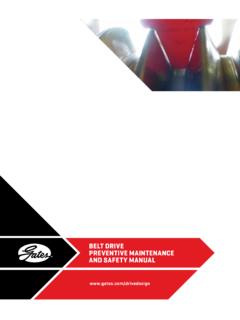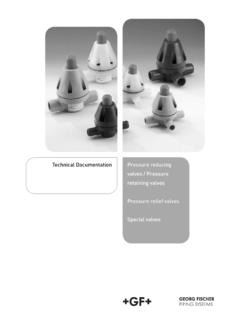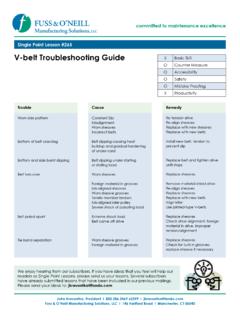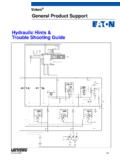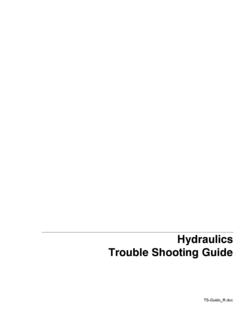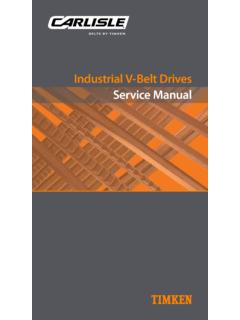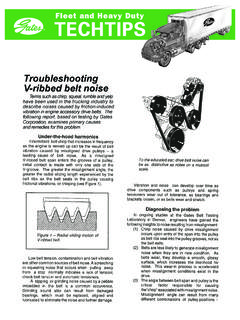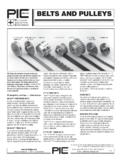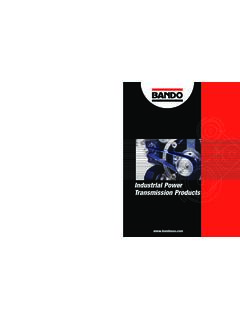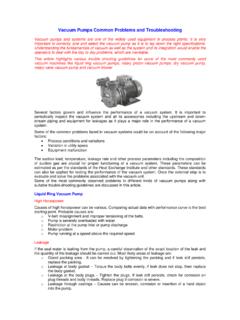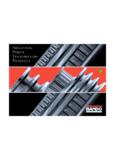Transcription of BELT DRIVE PREVENTIVE MAINTENANCE & SAFETY MANUAL
1 The Driving Force in Power Transmission belt DRIVE PREVENTIVE MAINTENANCE & SAFETY MANUALTABLE OF CONTENTSF oreword Why Have a PREVENTIVE MAINTENANCE Program? ..1 Maintaining a Safe Working Environment ..2 DRIVE Shutdown & Thorough Inspection Simple Inspection ..3 PREVENTIVE MAINTENANCE Checklist ..4 PREVENTIVE MAINTENANCE Procedure ..5 Measuring belt Tension ..7 Installation How to Install Belts ..12 How to Install Taper-Lock and QD Bushed Sheaves and Sprockets ..14 belt Storage and Handling ..16 belt Identification ..18 belt Types ..25 belt Styles ..28 belt DRIVE Performance.
2 32 Noise ..33 Sprocket Corrosion Prevention ..35 troubleshooting Guide ..37 Problem/Solution Summary Table ..39 troubleshooting Tools ..48 Technical Information ..51 Gates Publications ..62 DRIVE Survey Worksheet High Speed ..63 Low Speed ..64 Design IQ ..65 Copyright 2008 Gates CorporationDenver, Colorado 80217-5887 Printed in U .S . of AmericaSources of DRIVE ProblemsWhy have a PREVENTIVE MAINTENANCE program?When compared to the constant lubrication problems associated with chain drives, or the mechanical problems and high costs associated with gear drives, belts are the most cost-effective, reliable means of power transmission.
3 However, optimum belt DRIVE performance requires proper MAINTENANCE . The potential for long service life is built into every Gates belt . When coupled with a regularly scheduled MAINTENANCE program, belt drives will run rela-tively trouble-free for a long time .Important to your businessAn effective PREVENTIVE MAINTENANCE program saves time and money . Inspecting and replacing belts and faulty DRIVE components before they fail will reduce costly downtime and production delays .What is a good belt MAINTENANCE program?A comprehensive, effective program of PREVENTIVE mainte-nance consists of several elements: Maintaining a safe working environment.
4 Regularly scheduled belt DRIVE inspections. Proper belt installation procedures . belt DRIVE performance evaluations . belt product knowledge. belt storage and handling. DRIVE should have adequate guardCarefully inspect all belts* Note - If belt looks bad, it probably is1 Power should be shut off and controls locked before inspectingMaintaining A Safe Working EnvironmentIt is common sense to establish a safe working environment in and around belt drives . The following precautions will make belt DRIVE inspection and MAINTENANCE easier and safer .Wear Proper ClothingNever wear loose or bulky clothes, such as neckties, exposed shirttails, loose sleeves or loose lab coats around belt drives.
5 Wear gloves while inspecting sheaves or sprockets to avoid being cut by nicks, burrs or sharply worn pulley edges . Wear SAFETY glasses to avoid eye injuries . Don t be foolish! Wear proper clothing . This technician is not wearing SAFETY glasses, and his bulky lab coat and neck tie are hazards near moving components .Maintain Safe Access to DrivesAlways maintain safe access to the belt drives . Keep area around drives free of clutter, debris and other obstructions . Floors should be clean and free of oil and debris to insure good footing and balance while working on machinery . DRIVE GuardsAlways keep drives properly guarded.
6 Every belt DRIVE must be guarded when in operation . Guard must be designed and installed according to OSHA standards . A Properly Guarded belt DriveA properly designed guard has the following features: Completely encloses DRIVE . Grills or vents for good ventilation. Accessible inspection door or panels. Can easily be removed and replaced if damaged. Where necessary, should protect the DRIVE from weath-er, debris and damage .Follow these precautions to make your PREVENTIVE mainte-nance easier . FOREWORD2A properly guarded belt driveDon t clutter area around belt driveNo loose or bulky clothingPower should be shut off and controls locked before inspectingSimple DRIVE InspectionBegin PREVENTIVE MAINTENANCE with a periodic DRIVE inspec-tion as a normal part of your MAINTENANCE rounds.
7 Look and listen for any unusual vibration or sound while observing the guarded DRIVE in operation . A well designed and maintained DRIVE will operate smoothly and quietly .Inspect guard for looseness or damage . Keep it free of debris or dust and grime buildup on either the inside or the outside of the guard . Any accumulation of material on the guard acts as insulation, and could cause drives to run hot-ter . The effect of temperature on belt life is important . For example, an internal temperature increase of 18 F (or approximately 36 F rise in ambient DRIVE temperature) may cut belt life in half.
8 Also look for oil or grease dripping from guard . This may indicate over-lubricated bearings . If this material gets on rubber belts, they may swell and become distorted, leading to early belt failure .It s a good idea to check motor mounts for proper tightness . Check take-up slots or rails to see that they are clean and lightly lubricated .How Often To InspectThe following factors influence how often to inspect a DRIVE . Critical nature of equipment DRIVE operating cycle Accessibility of equipment DRIVE operating speed Environmental factors Temperature extremes in environmentExperience with specific equipment is the best guide to how often to inspect belt drives.
9 Drives operating at high speeds, heavy loads, frequent stop/start conditions and at tempera-ture extremes or operating on critical equipment require frequent inspection .When To Perform PREVENTIVE MaintenanceTo help establish a PREVENTIVE MAINTENANCE schedule, keep the following in mind .Critical DrivesA quick visual and noise inspection may be needed every one to two weeks .Normal DrivesWith most drives, a quick visual and noise inspection can be performed once a month .Complete InspectionA DRIVE shutdown for a thorough inspection of belts, sheaves or sprockets and other DRIVE components may be required every three to six months.
10 Remember, a well-designed industrial belt DRIVE is capable of operating for several years when properly maintained and used under normal conditions .Follow the PREVENTIVE MAINTENANCE Procedure on the fol-lowing page when performing detailed MAINTENANCE during equipment shutdowns . DRIVE SHUTDOWN & THOROUGH INSPECTION3 DRIVE SHUTDOWN & THOROUGH INSPECTION4 PREVENTIVE MAINTENANCE Check ListBy following these steps, belt drives can be maintained efficiently and safely .1. Always turn off the power to the DRIVE . Lock the con-trol box and tag it with a warning sign Down For MAINTENANCE . Do Not Turn Power On.
